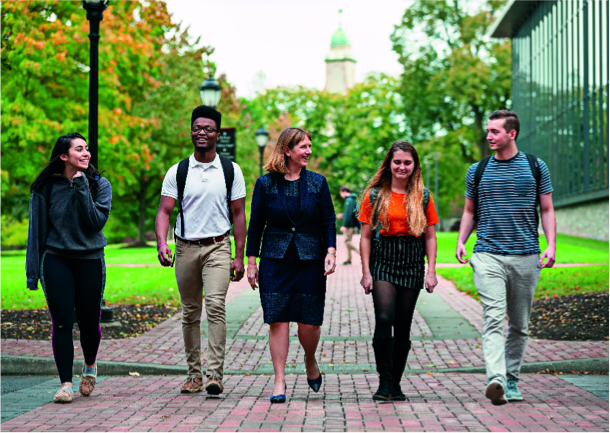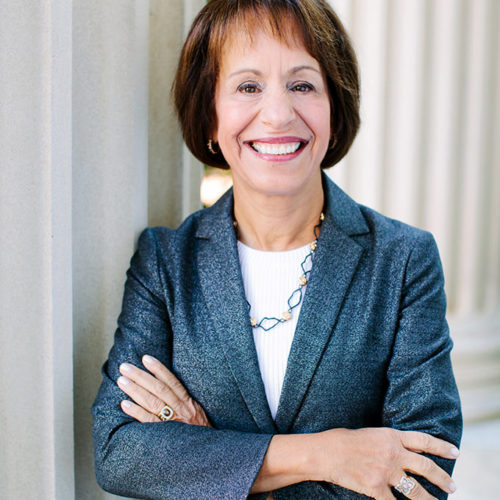Presidential Perspectives: Alison Byerly, Carleton College (and formerly Lafayette College)
November 5, 2019
Reading Time: 7 minutes

Lafayette College is working to grow its financial aid budget to support increased socioeconomic diversity. We spoke with President Alison Byerly to learn how this work is unfolding.
We constructed a plan that involved multiple sources to support increased financial aid. One of them, of course, is fundraising. Another is taking the first percentage point off the top of any tuition increase and putting that directly into financial aid, in addition to what we had previously been doing. But a third and important component of our plan was growing the size of our student body by 400 students over the course of six to eight years.
Q: What inspired you to become involved with the American Talent Initiative?
A: The formation of ATI could not have been better timed for what we were hoping to accomplish at Lafayette. We were in the process of launching a strategic direction premised around the idea of increased affordability, an initiative we call Affordability and Distinction through Growth. As the ATI effort was beginning, I benefitted from a lot of the early publicity and commentary about other institutions’ work and how ATI hoped to advance all of our efforts by giving us the opportunity to think about them as part of a larger collaborative effort.
When I came to Lafayette, I recognized that as strong as the college was, we weren’t keeping pace with the financial needs in our applicant pool; we were turning away talented students because we didn’t have enough aid to give. So as ATI was formed, I was able to use it as an example when talking to my board and community and say, “Look, this is now recognized as an urgent, national project. College and university presidents all across the country have the same notion, which is that we’re letting finances stand in the way of too many talented students’ education.”
Q: In last year’s American Talent Initiative Impact Report, increasing the size of the student body was cited as a strategy members used to expand opportunity for lower-income students. While most examples came from larger, public institutions, you have pursued this strategy at Lafayette, a smaller, private college. Why have you pursued this strategy? What advice do you have for smaller colleges considering this?
A: Growth has been foundational to our effort to become more affordable. We had a very strong applicant pool and recognized if we could increase tuition revenue, we could use those resources for financial aid. We constructed a plan that involved multiple sources to support increased financial aid. One of them, of course, is fundraising. Another is taking the first percentage point off the top of any tuition increase and putting that directly into financial aid, in addition to what we had previously been doing. But a third and important component of our plan was growing the size of our student body by 400 students over the course of six to eight years. We calculated that the amount of infrastructure we would need to add would not increase costs in a way that was proportional to the revenue we gained by having those additional students.
Our strategic direction is premised on the idea that this was the right moment for Lafayette to grow – that we had the capacity, we had the enrollment interest. And I would say to other colleges that every school is in a different place and has to judge for itself what its capacity is. But we have found that the energy and momentum we have built by adding more students and expanding the faculty have worked together to create a lot of positive momentum.
One of the questions that comes up on campus all the time is whether or not we’re doing enough to support the students we’re bringing in. As we bring in more students with more diverse socioeconomic backgrounds, our campus is constantly asking if we are doing everything we can for those students. We have been very engaged over the course of the last year or two in developing specific plans to support various underrepresented student groups and in gathering input from the community about places where they might feel that growth has created strains.
It is important to recognize when doing this work that growth is inherently challenging. It asks a lot of the community to be bringing in lots of new people and making them a part of that community. Making sure there is as much community conversation as possible about things like where we might need new staff or if we need more academic space has been very important. We had done a lot of planning, but it had happened more behind the scenes, and now we’ve had to lift the curtain and bring that conversation out into the community as a whole to give them confidence that we’re really ready for the community that we’re building.
Q: You mentioned “lifting the curtain” and involving others in the conversations about providing students with support and making sure growth is sustainable and inclusive. What does that look like in practice?
A: We’ve used a couple of different strategies. In the last year, one thing that was very helpful was we held a retreat with our board of trustees, a group of thirty or so faculty leaders, and some administrative staff. They all engaged in substantive discussions about how the strategic direction was going. This was not framed as an update on everything that was great; we picked out three areas that were particularly challenging and had workshops focused on those challenges. The board has committed to doing another retreat this year and potentially every year, just as they did last year because having the board, faculty, and administrative staff talk collectively turned out to be really powerful.
Q: Being “need-blind” in admissions is often an important component of expanding access. It remains an aspiration for many schools, Lafayette included. In the meantime, how can a school be—as one of your enrollment leaders put it—“responsibly need aware?”
A: We actually started out by saying that our goal was to become need-blind and our plan calculates what level of financial aid we think we need to get us there in 2026. But what we have found along the way is that being sensitive to what levels of need are represented in our pool is actually helpful in building the kind of socioeconomic diversity we want. In a way, being need-blind is a kind of proxy for having a socioeconomically diverse student body. It’s a very important flag to be able to plant and say that is where we want to be. But we would fully acknowledge that we are not there yet. Most of our admissions decisions aren’t affected by level of need, but there are some really tough calls made toward the end of the admissions process that really do come down to a set of folders that are students who can pay full price and a set of folders that are students who need what is left of our financial aid budget.
 What we really grapple with is: what does “responsibly need-aware” mean in terms of practice? Our admissions folks found it contradictory at first, but as we try to focus on being more accessible to students with need, we actually pay more attention to need. For example, we do still have some remaining merit aid and a merit fellowship program that is high-level and competitive. We now look at need as well as merit in awarding those merit scholarships, which we hadn’t done previously. We’re factoring need in in a more positive way and really trying to use every bit of information we have to figure out how we can have the greatest impact on the largest number of students.
What we really grapple with is: what does “responsibly need-aware” mean in terms of practice? Our admissions folks found it contradictory at first, but as we try to focus on being more accessible to students with need, we actually pay more attention to need. For example, we do still have some remaining merit aid and a merit fellowship program that is high-level and competitive. We now look at need as well as merit in awarding those merit scholarships, which we hadn’t done previously. We’re factoring need in in a more positive way and really trying to use every bit of information we have to figure out how we can have the greatest impact on the largest number of students.
A metaphor I used in my initial presentation to the board back in 2016, which now has become a regular part of the repertoire, is that becoming need-blind is like hiking up a mountain. You hope to get to the very peak, but the view gets better all along the way. Every step you take forward is giving you that broader view that you’re looking for. That doesn’t mean that you’re not still hoping and expecting to reach the summit, but it’s not as if the distance between here and there is a waste. Every step you take is an improvement.
Q: You mentioned merit aid. How do you think about striking the right balance between merit and need-based aid to accomplish ATI-related goals?
A: I would say that our objective has been to reduce our dependence on merit aid over time. We give many fewer merit awards than we did four to five years ago, and we changed to a competitive process that involves students coming to campus to be interviewed. A small number are selected as an honorific cohort, as opposed to the merit award simply being experienced as a discount coupon. We felt that we could be more comfortable retaining the level of merit that helps us remain competitive among our peers when it was really positioned not as discount off the tuition but as a genuine scholarship that students have won for specific excellence we can identify.
Q: We’ve heard—especially from smaller, more tuition-dependent private colleges—that maintaining a particular discount rate can sometimes come into tension with goals of advancing access and affordability for lower-income students. Nearly half of ATI’s progress to our 50,000-by-2025 is contingent on small private colleges increasing or maintaining commitments to access and opportunity. Can ATI goals be achieved without increasing the overall discount rate at tuition-dependent institutions? How have you navigated these conversations, in particular with your board of trustees?
When I first came to Lafayette, I recognized that our board was very proud of having a lower discount rate; it was then around 33-34%. They felt that in a time when a lot of schools’ discount rates were creeping up that we had to keep this budgetary item under control. They were somewhat taken aback when I said that this would actually be a problem; we would be a stronger institution and have stronger students if we raised the discount rate.
A: Our strategy actually was premised on the idea that increasing the discount rate would be a critical backbone of the plan. When I first came to Lafayette, I recognized that our board was very proud of having a lower discount rate; it was then around 33-34%. They felt that in a time when a lot of schools’ discount rates were creeping up that we had to keep this budgetary item under control. They were somewhat taken aback when I said that this would actually be a problem; we would be a stronger institution and have stronger students if we raised the discount rate. Our plan now focuses on slowly raising that rate and we’ve been going at about one percent a year, so we’re now at about 39%. But within that discount rate, there are so many different ways to distribute aid that different institutions will naturally have different approaches and I think there’s certainly improvement that can be made even if you’re not undertaking the more radical shift that we’re making, or what will feel like radical by the time we get there. We hope to be closer to the mid- to high-forties or higher by the end of the plan. That will be a big difference for us. But we think that for Lafayette that really represents a commitment of resources that needs to be made to bring in the strongest students. I would add that we have found in the three years of the plan so far that it has demonstrated that hypothesis beautifully. In each of the three years of the plan we have had the highest SAT and ACT scores we’ve ever had and also the most diverse student body. So that definitely proves that more financial aid gives you access to more talented students.
I would say that what worked best with our board was to appeal to their competitive instincts, which most boards of trustees have. I was able to point out that what separates us from the schools we aspire to resemble is that they are spending more on financial aid and they’re able to bring in stronger students for that reason. When I said we could bring stronger students and be a stronger school and look more like the schools we aspire to look like, that was compelling. And that’s again why ATI was so helpful. It allowed me to go to board meetings with an actual list of top schools in the country that are doing the exact same thing. That really hammered home the argument that this is what the best schools try to do, and we want to be considered among the very best schools.
Q: From everything you’ve learned about increasing access for low- and moderate-income students, what would you like to share with other ATI presidents? Particularly those at similar institutions?
A: I would just say that I value the collegial spirit behind ATI and the effect of having so many presidents trying to move in the right direction. I think we recognize that competitive forces can often move us in the wrong directions, so I feel very pleased and proud that we’re able to make some steps that we think are not only benefitting us competitively as an institution but more importantly benefitting a larger number of students. And I certainly encourage everyone who is on this same path to continue to look critically at the ways in which we deploy our aid, to try to look beyond the pressures of a particular enrollment cycle and look long term. We’re making a long-term investment that is a difficult climb for us right now but that will put us in a stronger position in the future, and we recognize that that’s what is important in this kind of difficult moment for higher education. I applaud the efforts that everyone is making to advance from whatever place they are to a better place. As institutions, we’re all in different places and I think that being able to share our experiences can be tremendously valuable.



